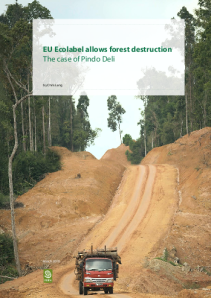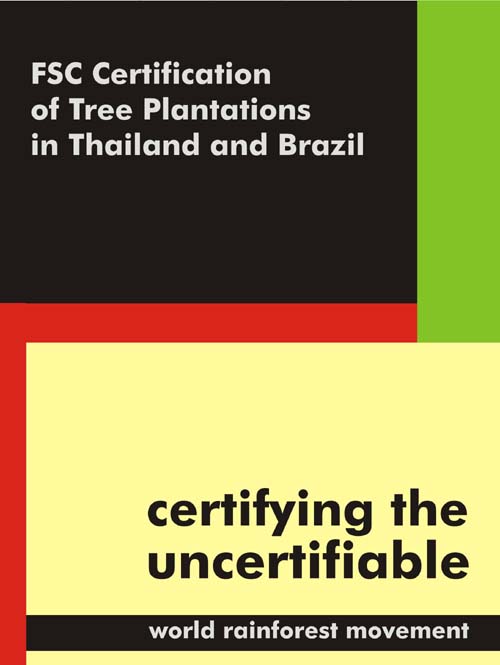Getting tired of the ever expanding REDD plans? Me too.
By Chris Lang, Published in Climate Chronicle No. 3, Transnational Institute’s COP-15 newspaper, 11 December 2009
The basic concept of Reduced Emissions from Deforestation and forest Degradation (REDD) is simple: governments, companies, local people and/or Indigenous Peoples in the South should be rewarded for protecting their forests instead of cutting them down. The devil is in the details. And there are an awful lot of details in REDD.
Forests were excluded from the Kyoto Protocol, as we all know, because it’s very difficult to measure how much carbon is stored in them. Even if you could measure the carbon, it’s very difficult to know whether the carbon is going to stay in the forests, and for how long, or whether the trees will burn down as the planet heats up. Then there’s the problem that if we stop deforestation in one area, how on earth do you stop the loggers from going somewhere else given that demand from Northern overconsumption hasn’t just gone away?
Forests came back into the UNFCCC in 2005 at COP11 in Montreal, when a group of countries led by Papua New Guinea introduced an idea called REDD. Two years later, at COP13 in Bali, REDD had morphed into REDD+.
The ‘Bali Action Plan’ Calls for:
“Policy approaches and positive incentives on issues relating to reducing emissions from deforestation and forest degradation in developing countries; and the role of conservation, sustainable management of forests and enhancement of forest carbon stocks in developing countries.”
In other words, REDD+ has added more details with new REDD devils hiding away in them:
- “conservation” sounds good, but the history of the establishment of national parks includes large scale evictions and loss of rights for Indigenous Peoples and local communities;
- “sustainable management of forests” would include subsidies to commercial logging operations in old-growth forests, indigenous peoples territory or in villagers community forests;
- “enhancement of forest carbon stocks” could result in conversion of land (including forests) to industrial tree plantations, with serious implications for biodiversity, forests and local communities. According to the UN, a “forest” is any area bigger than 500 square metres with crown cover of 10 per cent and trees capable of growing two metres high . Industrial
plantations and even clearcuts are included in this definition.
Just when you thought it was safe to go back into the forest, along came REDD++. The second plus refers all land uses. No, really – everything. By now the devils are positively swarming with glee.
Just to give an idea of how crazy this is, here is the Ugandan SBSTA negotiator, Xavier Nyindo Mugumya, speaking to the pro-carbon trading website, Ecosystem Marketplace during COP14 in Poznan last year, “Generally, we think the science is OK.” Well isn’t that nice to know? But that’s not all Mugumya had to say, “The problem is that we don’t have specificity of which science is suitable for deforestation and which science is suitable for degradation and which science is suitable for other areas like conservation and sustainable management of forests.” So adding in every emission from every time anyone digs up a weed in their back garden, as REDD++ would presumably have to do? Easy peasy.
There are a few other suggestions on the menu at Copenhagen: REDD, sausage and bacon; REDD and spam; REDD, bacon and spam; REDD, bacon, sausage and spam; spam, bacon, sausage and spam; spam, eggs, spam, bacon and spam; and spam, sausage, spam, spam, spam, bacon, spam, tomato and spam. Oh, I’m sorry. That’s a Monty Python sketch. Obviously, the UN climate negotiations are nothing like Monty Python.
The trouble is that REDD is not funny. REDD-type projects are already having major impacts on local communities and Indigenous Peoples. While REDD proponents such as the Nature Conservancy (TNC) are very friendly with massively polluting companies, they ignore the rights and needs of local communities. A TNC project in Guaraqueçaba, Brazil, for example, creates carbon credits for General Motors, Chevron and American Electric Power. The project has destroyed local people’s livelihoods by not allowing them into the forest. TNC doesn’t seem to care. “The carbon idea is not really tangible to people in the community,” Miguel Calmon, TNC’s director of forests and climate in Latin America told Investigative journalist Mark Schapiro.
While Guaraqueçaba is just one project, it exposes REDD as simply a means to help polluting corporations to “offset” their emissions. And there are a huge number of polluting companies looking to ‘offset’ their emissions. REDD could trigger the biggest land grab of all time.










Agroforestry, biochar and REDD+++
Access by the poor to land and natural resources getting increased financial value is an important challenge.
If agroforestry also in form well suited to the poor (contour hedges, hedgerow intercropping, and alley cropping) was included, then it could increase employment, small farmers demarcation of land rights, and reduce the need to clear more forests. Agroforestry can prevent nutrients being leached and eroded, can fix nitrogen and can suppress weed invasion (perennial grass like Imperata cylindrica, spear grass).
At my websites are links to my article on this issues including new low-cost methods for establishment of contour hedges which can reduce problems of unpredictable climate.
at last someone recommending agroforestry contour hedging for carbon offsetting. totally agree